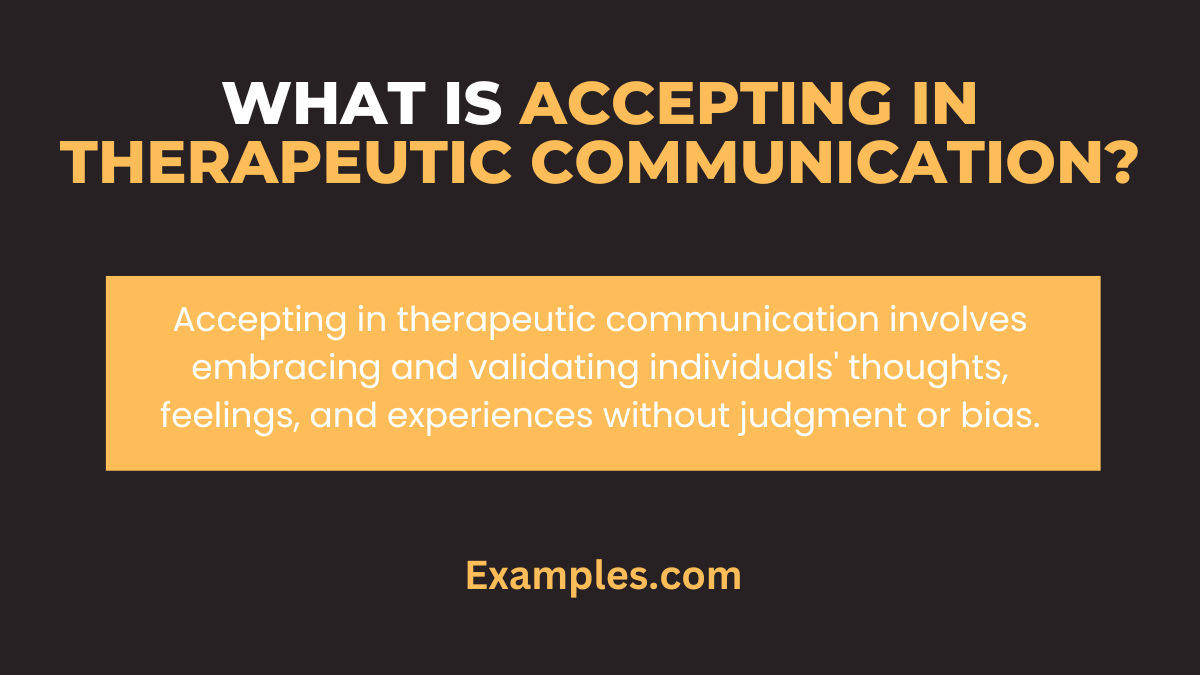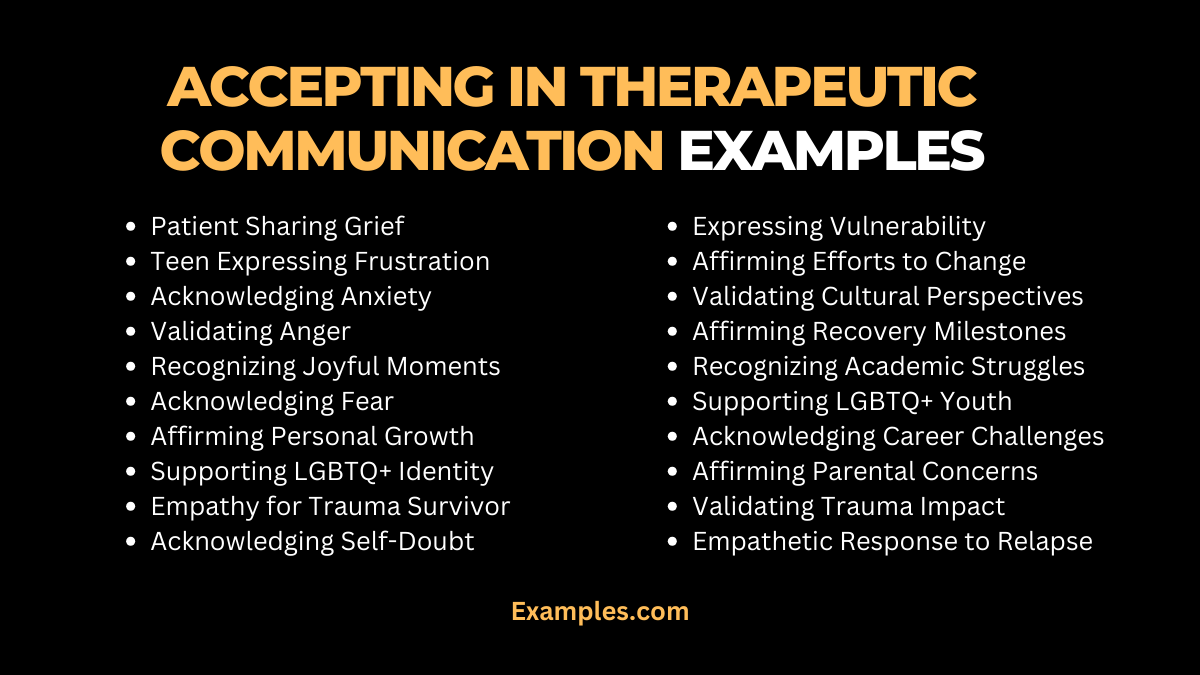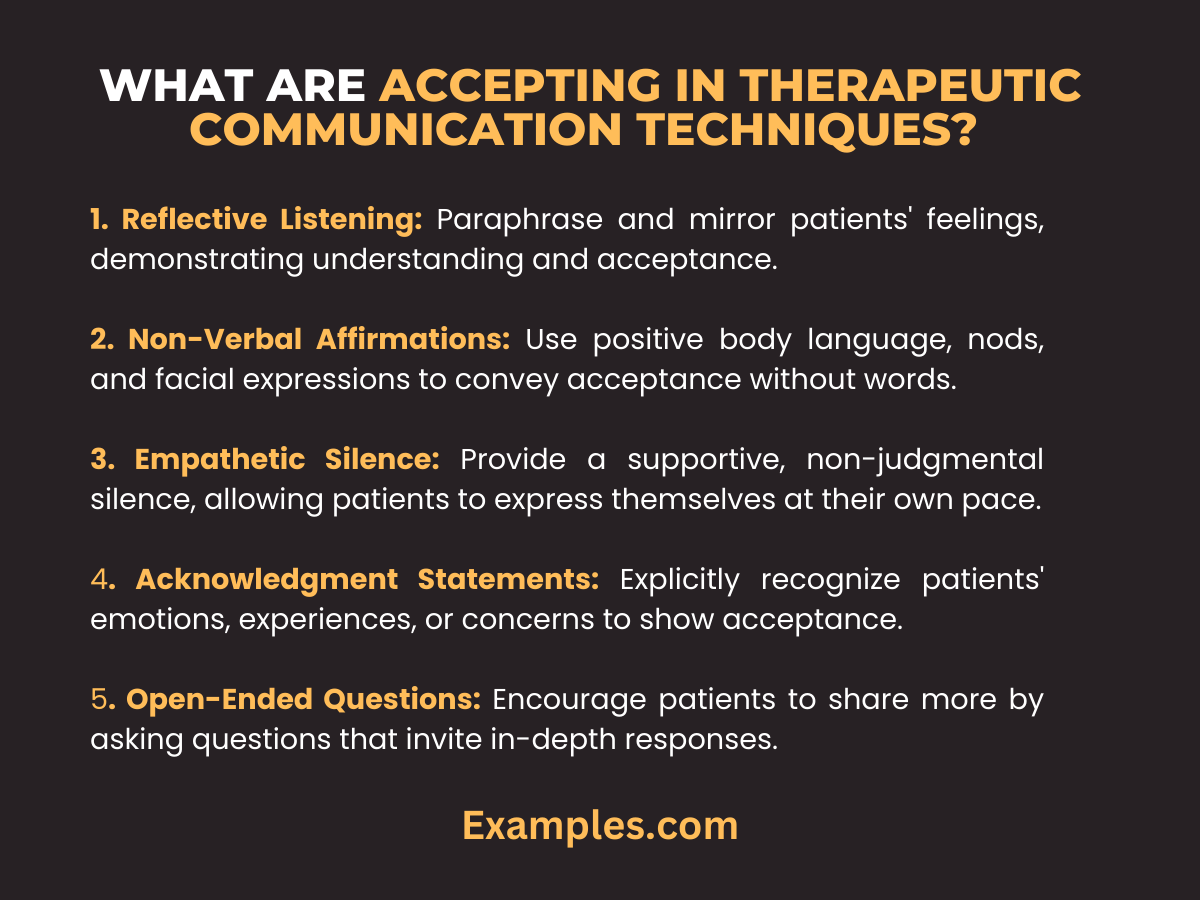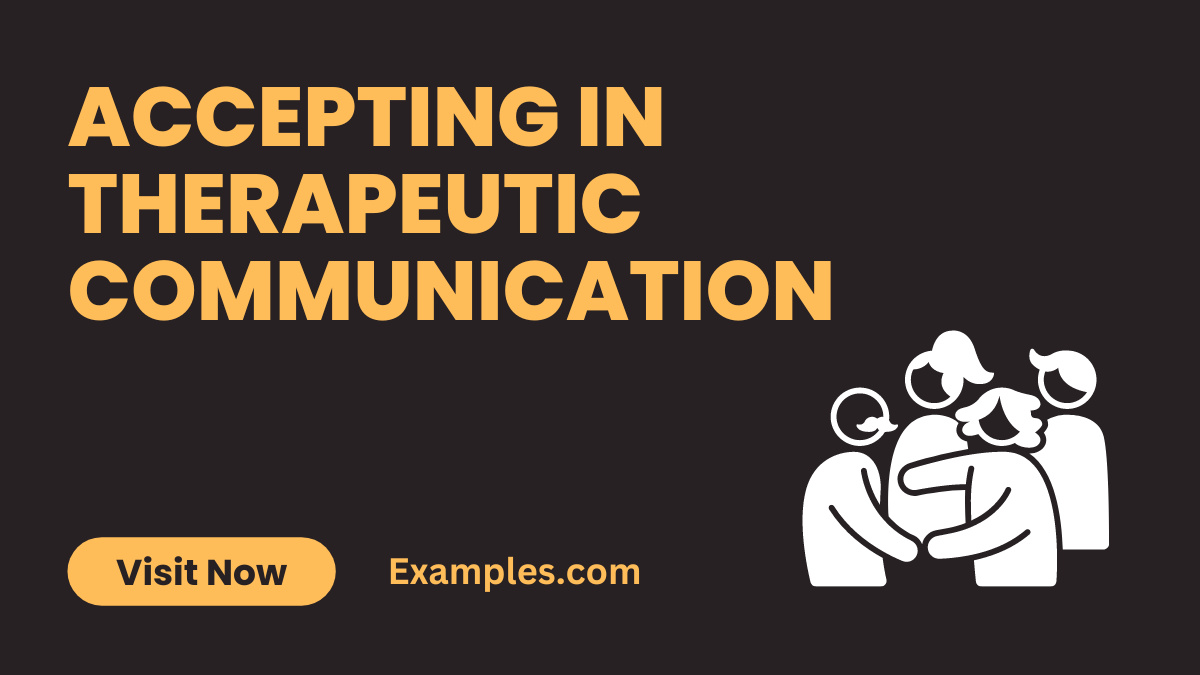19+ Accepting in Therapeutic Communication Examples
Embark on a transformative journey as we delve into Accepting in Therapeutic Communication. This comprehensive guide illuminates the power of acceptance, offering real-world Communication Examples to enhance your therapeutic skills. Discover how embracing acceptance fosters trust, empathy, and healing connections, and gain valuable insights to navigate the intricate dynamics of therapeutic relationships with confidence and compassion. Elevate your communication skills to new heights with practical wisdom and profound examples.
What is Accepting in Therapeutic Communication?

Accepting in therapeutic communication refers to the empathetic reception and acknowledgment of a person’s thoughts, feelings, or experiences without judgment. It involves creating a safe space where individuals feel heard and validated, fostering trust and openness in therapeutic relationships. Acceptance doesn’t necessarily imply agreement but underscores respect and understanding, forming a crucial foundation for effective communication and emotional support in therapeutic settings.
Accepting in Therapeutic Communication Examples

Acceptance in therapeutic communication involves affirming others’ experiences and emotions. Here are insightful examples:
- Patient Sharing Grief: “I hear your pain. Losing a loved one is incredibly tough. How are you coping?”
- Teen Expressing Frustration: “It sounds like school is overwhelming. Tell me more about what’s been bothering you.”
- Acknowledging Anxiety: “I see your anxiety. Let’s explore ways to manage it together. What has helped before?”
- Validating Anger: “Anger is a natural response. How can we channel it constructively in your situation?”
- Recognizing Joyful Moments: “Your joy is valuable. What activities bring you happiness and fulfillment?”
- Acknowledging Fear: “It’s okay to feel scared. Let’s work on strategies to navigate through your fears.”
- Affirming Personal Growth: “You’ve made progress. Reflect on your journey and the strengths you’ve discovered.”
- Supporting LGBTQ+ Identity: “Your identity is valid and respected here. How can I better understand and assist you?”
- Empathy for Trauma Survivor: “Surviving trauma is commendable. How can we address triggers and promote healing?”
- Acknowledging Self-Doubt: “It’s normal to doubt. Let’s explore your strengths and build self-confidence.”
- Expressing Vulnerability: “Sharing vulnerabilities takes courage. How can I support you in your journey?”
- Affirming Efforts to Change: “Recognizing the need for change is a significant step. What goals can we set together?”
- Validating Cultural Perspectives: “Your cultural background matters. How can I incorporate cultural sensitivity in our sessions?”
- Affirming Recovery Milestones: “Your progress is commendable. What strengths have you discovered during your recovery?”
- Recognizing Academic Struggles: “School challenges can be tough. How can we develop effective coping strategies?”
- Supporting LGBTQ+ Youth: “Your identity is valued. How can we create a safe space for your self-expression?”
- Acknowledging Career Challenges: “Work-related stress is real. Let’s explore strategies to improve your professional well-being.”
- Affirming Parental Concerns: “Your concerns as a parent are valid. Let’s discuss how to navigate these challenges.”
- Validating Trauma Impact: “Trauma leaves lasting effects. How can we work towards healing and resilience?”
- Empathetic Response to Relapse: “Relapses happen. Let’s understand the triggers and reinforce your recovery journey.”
Accepting in Therapeutic Communication Examples for Nursing Students
Acceptance in nursing communication is crucial for fostering trust and patient well-being. Here are examples tailored for nursing students:
- Acknowledging Patient Anxiety: “I sense your anxiety. Let’s discuss your concerns and explore coping strategies together.”
- Validating Pain Expression: “Pain is challenging. Share more about your pain level so we can address it effectively.”
- Empathizing with Family Worries: “Your family’s concerns matter. How can we involve them in your care plan for better support?”
- Affirming Treatment Decisions: “Your treatment choices are respected. Let’s ensure you’re well-informed and comfortable with them.”
- Acknowledging Cultural Influences: “Your cultural background impacts care. Share insights to tailor our approach to your preferences.”
- Supporting Lifestyle Adjustments: “Lifestyle changes are significant. Let’s work together to make adjustments that align with your goals.”
- Validating Recovery Milestones: “Your recovery achievements matter. Reflect on your progress and identify future goals.”
- Affirming Patient Autonomy: “Autonomy is vital. Share your preferences, and let’s collaborate on a care plan that aligns with your choices.”
- Expressing Compassion for Loss: “Loss is a complex emotion. How can I support you during this challenging time?”
- Acknowledging Uncertainty: “Uncertainty is normal. Let’s discuss your concerns and develop a plan to address them.”
Accepting in Therapeutic Communication Examples for Bipolar Disorder
Addressing acceptance in therapeutic communication for individuals with bipolar disorder is nuanced. Here are examples tailored for this context:
- Embracing Emotional Fluctuations: “Your emotional shifts are valid. Let’s explore coping mechanisms for both manic and depressive phases.”
- Affirming Medication Choices: “Medication decisions are personal. Share your experiences, so we can adjust and find what works best.”
- Validating Impact of Episodes: “Bipolar episodes impact daily life. How can we create strategies to manage these challenges?”
- Acknowledging Social Withdrawal: “Social withdrawal is understandable. Let’s find ways to maintain connections that align with your comfort level.”
- Supporting Sleep Patterns: “Sleep disruptions are common. Let’s explore techniques to regulate your sleep patterns for better stability.”
- Affirming Coping Mechanisms: “Your coping strategies matter. Let’s assess their effectiveness and enhance them for comprehensive well-being.”
- Expressing Understanding of Impulsivity: “Impulsivity is part of bipolar disorder. How can we develop strategies to minimize potential risks during impulsive moments?”
- Acknowledging Relationship Dynamics: “Relationship challenges are complex. Let’s navigate these dynamics together to improve interpersonal connections.”
- Empathizing with Rapid Thoughts: “Rapid thoughts can be overwhelming. Share your experiences, and we’ll work on slowing down and managing them.”
- Validating Goal Adjustments: “Adjusting goals is okay. Let’s revisit your aspirations, considering the impact of bipolar disorder, and set realistic targets.”
What are Accepting in Therapeutic Communication Techniques?

Accepting techniques in therapeutic communication are essential for building trust and rapport. Here are some effective techniques:
- Reflective Listening: Paraphrase and mirror patients’ feelings, demonstrating understanding and acceptance.
- Non-Verbal Affirmations: Use positive body language, nods, and facial expressions to convey acceptance without words.
- Empathetic Silence: Provide a supportive, non-judgmental silence, allowing patients to express themselves at their own pace.
- Acknowledgment Statements: Explicitly recognize patients’ emotions, experiences, or concerns to show acceptance.
- Open-Ended Questions: Encourage patients to share more by asking questions that invite in-depth responses.
- Validation of Feelings: Confirm the legitimacy of patients’ emotions, reinforcing that their feelings are understood and accepted.
- Cultural Sensitivity: Be aware of cultural nuances to ensure acceptance aligns with diverse backgrounds.
- Mindful Presence: Demonstrate full engagement and focus during interactions, reinforcing a sense of acceptance.
- Reflective Summarization: Recap patients’ narratives, emphasizing acceptance and understanding of their experiences.
- Affirmative Humming: Use subtle vocal cues like humming to convey attentiveness and acceptance.
How to Develop Accepting in Therapeutic Communication for Patient Care?
Developing acceptance in therapeutic communication is crucial for optimal patient care. Here’s a guide:
- Active Listening Skills: Sharpen active listening to pick up on verbal and non-verbal cues, enhancing overall acceptance.
- Cultivate Empathy: Practice understanding patients’ perspectives, fostering a genuine connection and acceptance.
- Continuous Learning: Stay informed about diverse patient experiences, enhancing your ability to accept various narratives.
- Adaptability: Be flexible in communication styles, adapting to individual preferences for better acceptance.
- Self-Reflection: Regularly reflect on personal biases and judgments that may hinder acceptance in therapeutic communication.
- Training and Workshops: Attend workshops on cultural competence, communication, and empathy to enhance acceptance skills.
- Peer Collaboration: Collaborate with peers to share experiences and insights, fostering a supportive environment for acceptance development.
- Patient Feedback: Seek feedback from patients about their perception of your communication style, specifically focusing on acceptance.
- Supervision and Mentoring: Engage in supervision and seek mentorship to receive guidance on improving acceptance in therapeutic communication.
- Role Play: Practice different scenarios through role play to refine your acceptance techniques and responses.
In conclusion, mastering the art of accepting in therapeutic communication is pivotal for fostering genuine connections and understanding. By embracing reflective listening, empathetic silence, and other techniques, practitioners can create a safe space for patients to express themselves. Cultivating acceptance enhances patient care, promotes open dialogue, and contributes to a compassionate and effective therapeutic environment.



